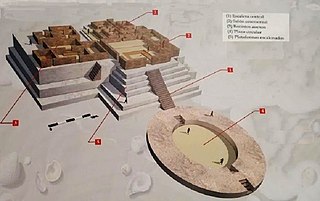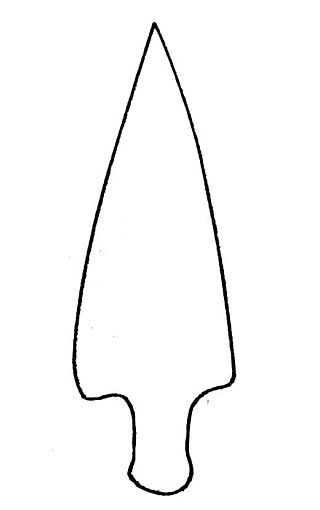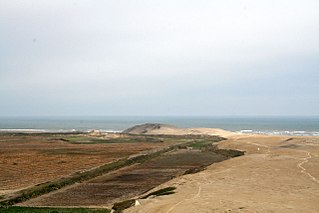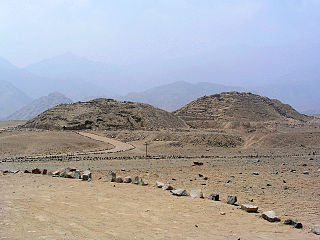Related Research Articles

In the history of art, prehistoric art is all art produced in preliterate, prehistorical cultures beginning somewhere in very late geological history, and generally continuing until that culture either develops writing or other methods of record-keeping, or makes significant contact with another culture that has, and that makes some record of major historical events. At this point ancient art begins, for the older literate cultures. The end-date for what is covered by the term thus varies greatly between different parts of the world.

La Libertad is a department and region in northwestern Peru. Formerly it was known as the Department of La Libertad. It is bordered by the Lambayeque, Cajamarca and Amazonas regions on the north, the San Martín Region on the east, the Ancash and Huánuco regions on the south and the Pacific Ocean on the west. Its capital is Trujillo, which is the nation's third biggest city. The region's main port is Salaverry, one of Peru's largest ports. The name of the region is Spanish for "freedom" or "liberty"; it was named in honor of the Intendancy of Trujillo's proclaiming independence from Spain in 1820 and fighting for that. It is the ninth smallest department in Peru, but it is also its second-most populous department after Piura and its second-most densely populated department after Lambayeque.

Monte Verde is a Paleolithic archaeological site in the Llanquihue Province in southern Chile, located near Puerto Montt, Los Lagos Region. The site is primarily known for Monte Verde II, dating to approximately 14,550–14,500 calibrated years Before Present (BP). The Monte Verde II site has been considered key evidence showing that the human settlement of the Americas pre-dates the Clovis culture by at least 1,000 years. This contradicts the previously accepted "Clovis first" model which holds that settlement of the Americas began after 13,500 cal BP. The Monte Verde findings were initially dismissed by most of the scientific community, but the evidence then became more accepted in archaeological circles. The site also contains an older, much more controversial layer suggested to date to 18,500 cal BP, that lacks the general acceptance of Monte Verde II.

Chan Chan, sometimes itself called Chimor, was the capital city of the Chimor kingdom. It was the largest city of the pre-Columbian era in South America. It is now an archeological site in the department of La Libertad five kilometers (3.1 mi) west of Trujillo, Peru.

The Huaca del Sol is an adobe brick pyramid built by the Moche civilization on the northern coast of what is now Peru. The pyramid is one of several ruins found near the volcanic peak of Cerro Blanco, in the coastal desert near Trujillo at the Moche Valley. The other major ruin at the site is the nearby Huaca de la Luna, a better-preserved but smaller temple.
Piki Mach'ay is an archaeological site in the Ayacucho Valley of Peru. Radiocarbon dating from this cave indicates a human presence ranging from 22,200 to 14,700 years ago, but this evidence has been disputed and a more conservative date of 12,000 years BCE seems possible.

Huaca de la Luna is a large adobe brick structure built mainly by the Moche people of northern Peru. Along with the Huaca del Sol, the Huaca de la Luna is part of Huacas de Moche, which is the remains of an ancient Moche capital city called Cerro Blanco, by the volcanic peak of the same name.

Located in the Chicama Valley, the El Brujo Archaeological Complex, just north of Trujillo, La Libertad Province, Peru, is an ancient archaeological site that was occupied from preceramic times. Considering the broad cultural sequencing, the Chicama Valley can be considered as an archaeological microcosm. Research at the site benefits from the favourable environmental and topological conditions for material conservation.

Aspero is a well-studied Late Preceramic site archaeological complex located near the mouth of the Supe River, south of Supe Puerto, on the central coast of Peru. It forms part of the ancient Caral-Supe civilization and was occupied during the Late Archaic period, from before 3000 BCE to around 1800 BCE. It is connected culturally to the ancient city of Caral, located 25 km up-valley, for which it presumably served as a major fishery. The site covers an area of approximately 14 hectares and features numerous temples or huacas, of which the most prominent are the Huaca Alta, the Huaca de los ídolos and the Huaca de los Sacrificios. Remains of human sacrifice have been found in the latter, dated to about 4500 years ago.

Tom Dalton Dillehay is an American anthropologist currently serving as the Rebecca Webb Wilson University Distinguished Professor of Anthropology, Religion, and Culture, as well as a Professor of Anthropology at Vanderbilt University. He has previously held teaching positions at the Universidad Austral de Chile and the University of Kentucky. Dillehay received his advanced degrees in anthropology from the University of Texas at Austin. He established anthropology departments at the Pontifical Catholic University of Chile in Temuco and at Austral University of Chile in Valdivia.

Ventarrón is the site of a 4,500-year-old temple with painted murals, which was excavated in Peru in 2007 near Chiclayo, in the Lambayeque region on the northern coast. The site was inhabited by the Early Cupisnique, Cupisnique, Chavin and Moche cultures.

The Lima culture was an indigenous civilization which existed in modern-day Lima, Peru during the Early Intermediate Period, extending from roughly 100 to 650. This pre-Incan culture, which overlaps with surrounding Paracas, Moche, and Nasca civilizations, was located in the desert coastal strip of Peru in the Chillon, Rimac and Lurin River valleys. It can be difficult to differentiate the Lima culture from surrounding cultures due to both its physical proximity to other, and better documented cultures, in Coastal Peru, and because it is chronologically very close, if not over lapped, by these other cultures as well. These factors all help contribute to the obscurity of the Lima culture, of which much information is still left to be learned.

The Andean civilizations were South American complex societies of many indigenous people. They stretched down the spine of the Andes for 4,000 km from southern Colombia, to Ecuador and Peru, including the deserts of coastal Peru, to north Chile and northwest Argentina. Archaeologists believe that Andean civilizations first developed on the narrow coastal plain of the Pacific Ocean. The Caral or Norte Chico civilization of coastal Peru is the oldest known civilization in the Americas, dating back to 3500 BCE. Andean civilizations are one of at least five civilizations in the world deemed by scholars to be "pristine." The concept of a "pristine" civilization refers to a civilization that has developed independently of external influences and is not a derivative of other civilizations.

The Paiján culture was an archaeological culture that emerged on the northern coast of Peru between 13,000 and 10,000 cal BP. It was first described by Peruvian archaeologist Rafael Larco Hoyle in the 1940s from the Pampa de los Fósiles site. Later research, mainly by French archaeologist Claude Chauchat, identified dozens of open air sites, which include camps, workshops and quarries.

Huaca Prieta is the site of a prehistoric settlement beside the Pacific Ocean in the Chicama Valley, just north of Trujillo, La Libertad Province, Peru. It is a part of the El Brujo Archaeological Complex, which also includes Moche (culture) sites.

The precolonial history of Chile refers to the period from the first human populations in the territory of Chile until the first European exploration of the region, by Spaniard Diego de Almagro in 1535–36.

The history of human habitation in the Andean region of South America stretches from circa 15,000 BCE to the present day. Stretching for 7,000 km (4,300 mi) long, the region encompasses mountainous, tropical and desert environments. This colonisation and habitation of the region has been affected by its unique geography and climate, leading to the development of unique cultural and societal organisations.

The Lady of Cao is a name given to a female Moche mummy discovered at the archeological site El Brujo, which is located about 45 km north of Trujillo in the La Libertad Region of Peru.

The Andean preceramic refers to the early period of human occupation in the Andean area of South America that preceded the introduction of ceramics. This period is also called pre-ceramic or aceramic.
The coastal migration hypothesis is one of two leading hypotheses about the settlement of the Americas at the time of the Last Glacial Maximum. It proposes one or more migration routes involving watercraft, via the Kurile island chain, along the coast of Beringia and the archipelagos off the Alaskan-British Columbian coast, continuing down the coast to Central and South America. The alternative is the hypothesis solely by interior routes, which assumes migration along an ice-free corridor between the Laurentide and Cordilleran ice sheets during the Last Glacial Maximum.
References
- Dillehay, Tom. The Settlement of the Americas: a new prehistory. New York: Basic Books, 2000.
- Dillehay, Tom, Duccio Bonavia and Peter Kaulicke. "The first settlers". In Helaine Silverman (ed.), Andean archaeology. Malden, MA: Blackwell, 2004, pp. 16–34.
- Lavallée, Danièle. The first South Americans: the peopling of a continent from the earliest evidence to high culture. Salt Lake City: University of Utah Press, 2000.
- Moseley, Michael. The Incas and their ancestors: the archaeology of Peru. London: Thames and Hudson, 2004.